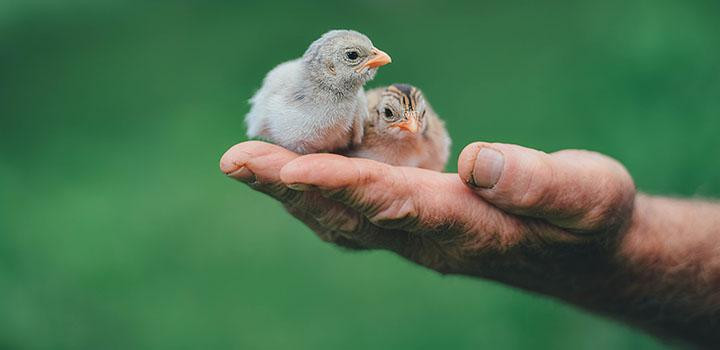
How to Raise Your Baby Guineas
Posted by Grange Co-op on 30th Aug 2015
 Baby Guineas require a brooder temperature of approximately 95 degrees for the first week, dropping approximately 5 degrees every 3 days or so until the end of the brooding period. Watch them closely to see if they are comfortable: If they cluster under the lamp, they are too cold; if they stay far away, drop their wings and pant, they are too hot; and if they range all over the brooder, they are comfortable. Always make sure they have a place to get away from the heat. They are usually fairly quiet when they are happy. Guineafowl can go outside when they are fully feathered. You may want to still give them heat at night if the weather is chilly.
Baby Guineas require a brooder temperature of approximately 95 degrees for the first week, dropping approximately 5 degrees every 3 days or so until the end of the brooding period. Watch them closely to see if they are comfortable: If they cluster under the lamp, they are too cold; if they stay far away, drop their wings and pant, they are too hot; and if they range all over the brooder, they are comfortable. Always make sure they have a place to get away from the heat. They are usually fairly quiet when they are happy. Guineafowl can go outside when they are fully feathered. You may want to still give them heat at night if the weather is chilly.
Guineas require a 28% protein starter feed. Grange Co-op offers Purina® Gamebird & Turkey Startena® (1718485). Feed them a starter feed for approximately 6-8 weeks, then gradually change over to an 18% protein all-purpose ration. Grange Co-op offers Rogue All-In-One (25AIO-50AIO). After the first couple of weeks, you can sprinkle a little chick grit on their feed, like you would salt your food.
Never give Guinea keets cold water, or they may become chilled and die. Use only lukewarm water. Change their water daily, or more often if it gets dirty. Use a no-drown waterer with a small gamebird base, or if you must use a chick waterer, place marbles into the water to keep them from getting into it, but they will still be able to drink.
Guinea keets must be kept dry and warm, as they are very fragile when they are young. Keep their litter clean and dry. Once they are fully feathered, they are very hardy and rarely catch diseases or become ill. Never catch them by their legs like a chicken, as the legs are delicate and can break easily if you do this.
Guineas do not do well with pelleted feed, but like crumbles and seeds. They will appreciate cracked corn, whole wheat, millet, sunflower seeds, greens andbugs as treats. In fact, you can easily train guineas to come in at night by teaching them to come for treats.
Once they are out of the brooder, keep them in their pen for 2-4 weeks, then you can begin to let them range during the day. It is best to lock them up at night, as you will lose many of them to predators (especially owls) at night, even though they may roost in the trees. A high roost or two in their pen will keep them happy. Many hens are also lost once they lay their nest full of eggs and begin to set. Either gather the eggs daily, or if you wish them to set, try and keep them in a pen with a quiet, dark area where they can lay their eggs and set on them. They usually begin to set once they have 25-35 eggs in a nest. Make sure they can't take their keets out into the dewy grass or they will become wet and chilled and you will lose them. They do not make very good mothers, unless they have a dry, secure place to raise their young.
Many people ask how to sex guineafowl. The most simple and accurate way is to listen to their voices. Hens will have a two-syllable call that sounds something like "buckwheat, buckwheat" (only hens can make this call). Both can make a one-syllable call like "kickkkkk kickkkkk". The males also have larger gills or wattles, and they are slightly cup-shaped. Their helmets (the part sticking up on top of the head) are larger as well.
Guineafowl will help keep your property free of ticks, snakes, and insects, and will warn you if anything is amiss. Guineas are very noisy and will make quite a racket when anything is out of the ordinary, or sometimes just for the fun of it.
